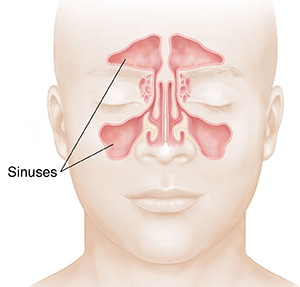Treating Chronic Sinusitis
Treating Chronic Sinusitis
The sinuses are hollow areas formed by the bones of the face. Sinuses make and drain mucus. This keeps the nasal passages clean and moist. When the sinuses become swollen (inflamed) or infected, the condition is called sinusitis. Symptoms may include:
Thick, discolored drainage from the nose
Nasal congestion
Pain and pressure around the eyes, nose, cheeks, or forehead
Headache
Cough
Thick mucus draining down the back of the throat (postnasal drainage)
Fever
Loss of smell
With chronic sinusitis, the symptoms last more than 12 weeks.
Ongoing prevention
It’s important to treat the cause of a sinus problem. If you have allergies, talk with your doctor about treatment. Or ask about getting an evaluation by an allergy specialist. If you’re exposed to nasal irritants such as sawdust, use a filter mask. If you smoke, ask your doctor for help with quitting. Smoke irritates the sinuses and can make your sinus problem worse. If you live with smokers, ask them to consider quitting or only smoking outdoors.
Medicine
Medicines for sinusitis may include:
Antibiotic medicines. You may need to take antibiotic medicine for a longer period. If bacteria aren't the cause, antibiotics won't help.
Inhaled corticosteroid medicine. Nasal sprays or drops with steroids are often prescribed.
Other medicines. You may need to take nasal sprays with antihistamines and decongestants, or saltwater (saline) sprays or drops. Your provider may also prescribe mucolytics or expectorants to loosen and clear mucus.
Allergy shots (immunotherapy). If you have nasal allergies, shots may help reduce your sensitivity to allergens such as pollen, dust mites, or mold.
If your symptoms still do not get better, you may need more testing. This may include a CT scan of the sinuses.
Surgery
If other treatments don’t solve the problem, you may need surgery. The type of surgery depends on what is causing your sinusitis. It also depends on which sinuses are involved. Your doctor will tell you more about your options. The types of surgery include:
Endoscopic surgery. This is often used to clear blockages. The sinuses can then heal on their own. During the surgery, the doctor uses a thin, lighted tube (endoscope). The doctor puts the endoscope into your nose to see into the sinuses. This surgery can be done without incisions on the face.
Open surgery. This is often used to clean out a sinus lining that is very damaged. It lets the doctor reach areas that an endoscope may not reach.
Updated:
March 21, 2017
Sources:
Acute sinusitis and rhinosinusitis in adults: Clinical manifestations and diagnosis. UpToDate.
Reviewed By:
Fraser, Marianne, MSN, RN,Image reviewed by StayWell medical illustration team.,Kacker, Ashutosh, MD
